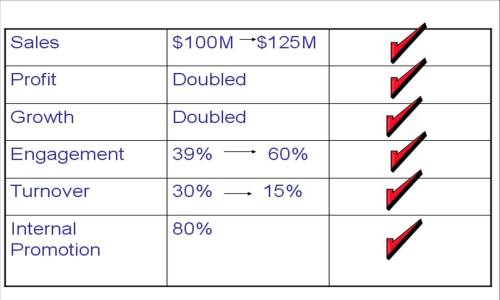Yesterday morning I attended a breakfast seminar which was hosted by 2Discover in at Martin Place. They had organised for Jann Gray, HR director for Ecolab and winner of ‘best HR strategic plan’ to speak, and it gave everyone present an opportunity to follow the amazing 4 year journey of a company that needed to implement major change or perish to the competitors.
Ecolab is a leading provider of cleaning, food safety and health protection products and services. They employ over 400 staff in Australia and service over 8000 customers nationally.
Jann explained that Ecolab were in a bad situation. They were turning over more than 1/3 of their staff each year, revenue was decreasing and a Hewitt survey revealed a very low employee engagement score.
Quoting Jim Parker- CEO South West Airlines- Jann explains that
“The outcome of a successful strategy is having the right people in the right jobs focused on the right things that lead to the business outcomes required.”
Essentially, it’s the way I see talent management but coming from a CEO it really ties the HR strategy to the impact it has on the bottom line.
I’ll briefly take you through a few of the different pieces of the Ecolab puzzle.

Revamped recruitment and selection policies
After a review of the types of staff they currently had, and assessing what sort of staff they needed in the future, Ecolab realised they needed to revamp their recruitment and selection processes to ensure they were hiring the right people in the right jobs. Previously they were hiring applicants purely on the basis of the technical ability, industry experience and knowledge of the industry. They then realised that they needed people in the future with leadership potential, not just technical strengths. As a result, psychometric testing was introduced in addition to second interviews with senior management. They then looked to training these hires internally to get their technical ability up to the level required.
Talent management/succession planning
At Ecolab, they conducted a succession planning process using the nine box matrix below to identify leadership potential and leverage this potential to drive performance. While there is nothing ground breaking about this matrix, it was an important part of the strategy that was done well.

Accountability
Another key part of this HR strategy was setting targets and holding people accountable to these targets. Part of this was utilising a scorecard for each business unit and publishing these results to hold people accountable to these newly defined metrics. For most business units, names weren’t published with scores; however for the Sales team publishing names and results was a motivating factor in achieving performance. This scorecard ensured that people were working on the right things.
Rewards and recognition
Additionally, Ecolab reviewed their compensation to ensure that they were rewarding the right behaviours.
I really liked the ‘Making a difference” program that Jann mentioned. Ecolab has six cultural values (and yes Jann was able to name all six!) and they wanted to recognise people that were living the values. In order to celebrate their successes, staff are able to nominate people have demonstrated the values through sharing the story. As a reward, the individual received a wine glass with the particular value printed on it. Funnily enough, this inspired staff to obtain a set of six wine glasses because after that you were given a bottle of wine to go with it!
What an effective and low cost initiative that celebrates the success of your people. In conjunction with an EVP like “the solution is you”, it is a winning strategy.
Finally Jann stated that communication was the key to the whole thing and with out communicating the key messages to people at the time they were happening, the strategy would not have been embedded in the way that it was.
So how do we tie this HR strategy to the impact it has on the bottom line? The results speak for themselves.

Congratulations Jann and the team at Ecolab, and thanks to the team at 2discover for presenting a fantastic seminar.







